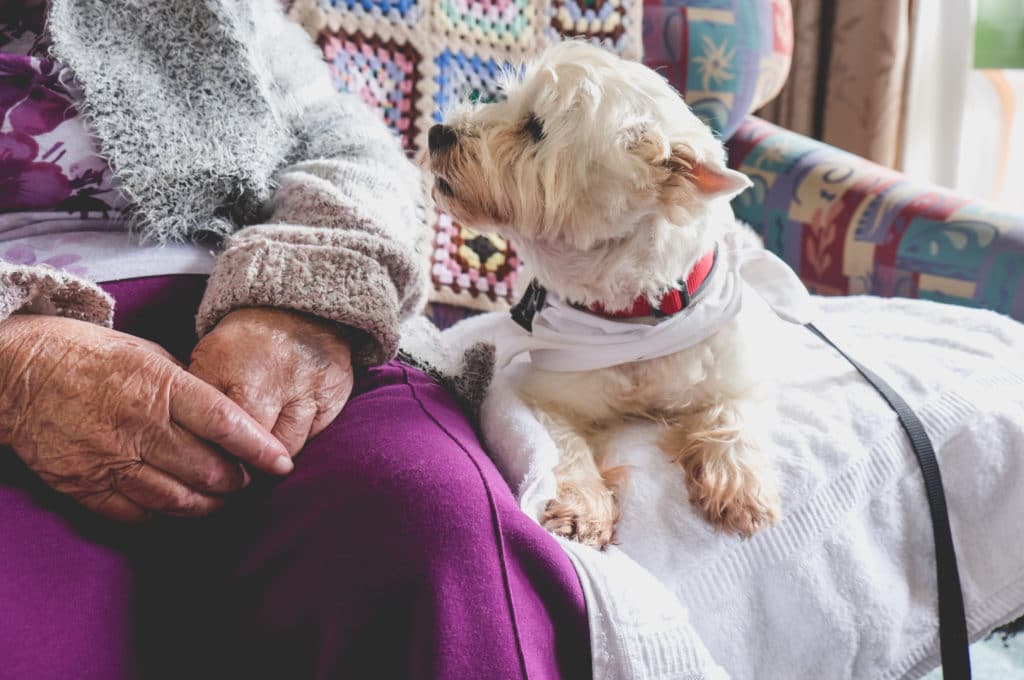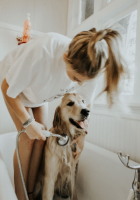People are quickly discovering the health benefits of therapy dogs. For those of you who don’t know, therapy dogs offer more than support. They provide relief to people prone to anxiety in stressful situations. They can help comfort those who are lonely and even give warmth and affection to people who are in nursing homes and hospitals. If you are wondering how to make your dog a therapy dog and how to certify your him, this article is for you.
By now, you’ve probably heard of service dogs. Unlike service dogs, therapy dogs give emotional support and comfort usually to people in institutions rather than provide a particular service for an individual with special needs.
Emotional Support Animal

Therapy dogs can bring many benefits to the people they visit. We’re talking about real benefits, such as:
- Lower blood pressure and heart rate
- Reduce anxiety
- Increase levels of endorphins and oxytocin
The best part? It’s a mutual association. Studies revealed that therapy dogs also benefit from this activity. Levels of endorphins and oxytocin are much higher in these dogs than normal pets.
But how does it all work? Does one get a new dog and train to become a therapy dog, or can you train your old family dog? Although your dog may be the sweetest boy ever, that doesn’t mean they’ll be a good fit for therapy practice. So, what exactly makes a certified therapy dog?
Training a Therapy Dog
Training a therapy dog is no easy task. For starters, dogs must have reached adulthood to be trained as a therapy dog. That’s not it. Most institutions require dogs to pass the Canine Good Citizen(CGC) exam for obedience before they can be introduced to the public. Certification is usually the last step in a long process toward your dog becoming a therapy dog. This final evaluation covers training, temperament, and so much more.
While you can try to train your dog on your own, the best way to go about it is with the assistance of well-educated instructors. We get it; private coaching can be expensive, so you might have no choice but to tackle this on your own. If you have no choice, we recommend starting with the CGC test for the ten essential commands, then work your way up with a few YouTube videos.
Another good option is by taking a group Canine Good Citizen class and follow that up with further specialized courses for a better grasp and understanding of the practice.
Before you can take your dog anywhere, your buddy has to pass the CGC test for obedience. If your dog can’t “drop it” on cue or lovingly socialize with kids, your pet will not be certified. Apart from compliancy, your dog must have a natural social temperament and must want the position.
How to Make Your Dog a Therapy Dog
If you’re planning on taking this on by yourself, you might want to start with a simple obedience exercise to help your dog get fit for that therapy dog lifestyle. This kind of compliance training can be easily performed at home or with the assistance of an instructor. The main advantages of an obedience exercise include promoting a sympathetic, respectful connection between you and your dog and providing accurate means of communication.
For a therapy dog to be successful in his vocation, it’s important that he or she enjoys spending time with other humans, not just you or your closest peers, but new people as well. A therapy dog must enjoy giving comfort to others and naturally seek out interplays.
You’ll know your dog can be trained as a therapy dog if he/she exhibits some of the following:
- Structure: How is your dog built? A dog with a solid build will usually be healthier than a smaller dog that can have certain underlying bone complications.
- Social Magnetism: How well your dog interacts with people and whether it is trusting and open to new interactions.
- Self-control: Is your dog well mannered in stressful situations? A dog’s behavior in certain situations will tell if he/she is cut out for therapy work.
- Retrieving: How good is your puppy at doing things on command? If your answer is ‘pretty good’, then your buddy has earned himself a point.
- Sound Sensibility: How does your dog react to loud noises? A quick way of determining that is by clapping your hands. Does your dog look toward you, and most importantly, does he approach you? Doing this also helps test for deafness.
- Sight Sensibility: When you make eye contact with your dog, does he engage in eye contact as well? This is a significant signal to your dog’s level of confidence.
- Balance: Is your dog quickly agitated or startled when confronted with a foreign object?
Getting Your Therapy Dog Training Certification
Training your dog to become a therapy dog will require a lot of work from both yourself and your dog. It takes more than just impeccable obedience for your dog to become a good therapy dog. Some of the most highly-trained dogs in the world may not be fit for therapy work simply because of their personality. On the other hand, some loving dogs, with the right training techniques, may reveal to be wonderful therapy dogs. Here are some tips for getting your training certification.
- Socialization- Introduce your dog to new places, people, and sounds.
- Take the obedience test and obtain the AKC Canine Good Citizen certification for your dog. Train essential actions for therapy work, such as “leave it” and not heedlessly jumping on new people.
- Consider following up with the Advanced Canine Good Citizen (AKC Community Canine) title.
- Enroll your buddy in a group therapy dog class. Such a course will prepare you and your newly graduated dog for visits.
- Upon passing your test, register with a national therapy dog organization to start doing visits and comfort anxious souls.
Takeaway
You’re all set! But remember, it’s your duty to stay up to date with your dog’s training and make sure that he is always at the top of his game. A polite, mannerly dog that loves meeting new people can become a fantastic therapy dog and make a real difference in the lives of the people that he visits. Unlike service dogs, accredited therapy dogs are permitted in places where normal dogs are allowed, so you’re all good on that front.











